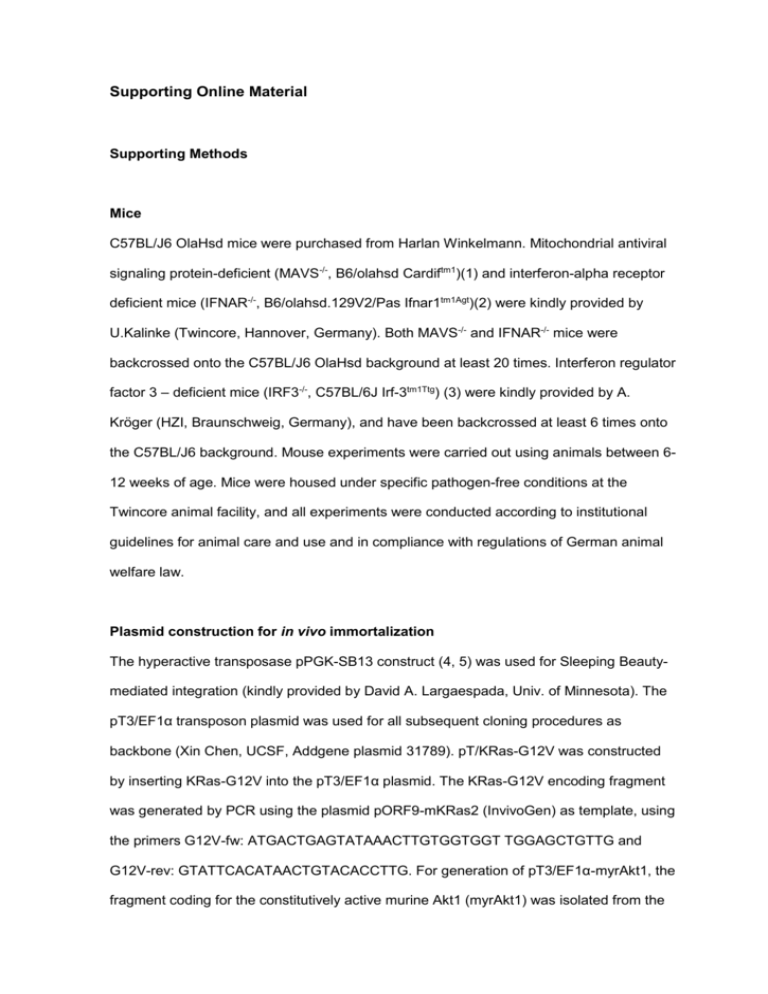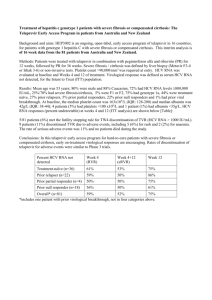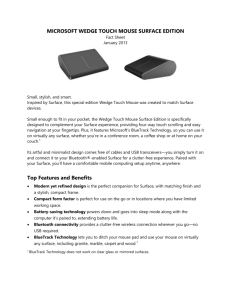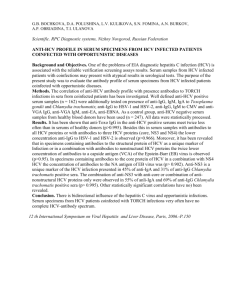hep26626-sup-0001-suppinfo
advertisement

Supporting Online Material Supporting Methods Mice C57BL/J6 OlaHsd mice were purchased from Harlan Winkelmann. Mitochondrial antiviral signaling protein-deficient (MAVS-/-, B6/olahsd Cardiftm1)(1) and interferon-alpha receptor deficient mice (IFNAR-/-, B6/olahsd.129V2/Pas Ifnar1tm1Agt)(2) were kindly provided by U.Kalinke (Twincore, Hannover, Germany). Both MAVS-/- and IFNAR-/- mice were backcrossed onto the C57BL/J6 OlaHsd background at least 20 times. Interferon regulator factor 3 – deficient mice (IRF3-/-, C57BL/6J Irf-3tm1Ttg) (3) were kindly provided by A. Kröger (HZI, Braunschweig, Germany), and have been backcrossed at least 6 times onto the C57BL/J6 background. Mouse experiments were carried out using animals between 612 weeks of age. Mice were housed under specific pathogen-free conditions at the Twincore animal facility, and all experiments were conducted according to institutional guidelines for animal care and use and in compliance with regulations of German animal welfare law. Plasmid construction for in vivo immortalization The hyperactive transposase pPGK-SB13 construct (4, 5) was used for Sleeping Beautymediated integration (kindly provided by David A. Largaespada, Univ. of Minnesota). The pT3/EF1α transposon plasmid was used for all subsequent cloning procedures as backbone (Xin Chen, UCSF, Addgene plasmid 31789). pT/KRas-G12V was constructed by inserting KRas-G12V into the pT3/EF1α plasmid. The KRas-G12V encoding fragment was generated by PCR using the plasmid pORF9-mKRas2 (InvivoGen) as template, using the primers G12V-fw: ATGACTGAGTATAAACTTGTGGTGGT TGGAGCTGTTG and G12V-rev: GTATTCACATAACTGTACACCTTG. For generation of pT3/EF1α-myrAkt1, the fragment coding for the constitutively active murine Akt1 (myrAkt1) was isolated from the plasmid RCAS-myrAkt (Sandra Orsulic, MSKCC, Addgene plasmid 11547) and cloned into pT3/EF1α. For targeted knockdown of p53, we constructed the plasmid pT3/EF1αshRp53, which expresses a shRNA against p53 (shRp53). To this end, the shRp53 fragment was excised from the LMP-construct (Open Biosystems, Huntsville, Al) and inserted into the pT3/EF1α transposon plasmid. Plasmids The plasmids pFK-Jc1, pFK-Luc-Jc1, pFK-Luc-SGR, pFK-Luc-SGRΔGDD, and pFK-LucJc1mCD81 have been described earlier (6-9).The plasmid pTRIP-pre-miR-122-puro was a kind gift from Matt Evans (10). The lentiviral plasmids pWPI-hApoE-BLR and pWPImApoE-BLR encode the human ApoE3 or mouse ApoE variants. Lentiviral plasmids pWPI-humanCD81-BLR, pWPI-mouseCD81-BLR, pWPI-humanOCLN-Gun, pWPImouseOCLN-Gun, pWPI-humanSR-BI-Gun, pWPI-mouseSR-BI-Gun, pWPIhumanCLDN1-BLR and pWPI-mouseCLDN1-BLR encode the human or mouse orthologs of the four HCV entry receptors in the context of the self-inactivating lentiviral vector pWPI as published previously (9). Lentiviral plasmids pSFFV_hu.pre.miR-122 and pSFFV_mmu.pre.miR-122a encode human respectively mouse genomic miR-122 sequence (detailed cloning strategies available upon request). Cell culture and generation of stable cell lines Huh-7.5 cells as well as all subcloned in vivo immortalized mouse liver-derived cell lines were cultured in Dulbecco's modified Eagle medium (DMEM; Invitrogen, Karlsruhe, Germany) supplemented with 2 mM L-glutamine, non-essential amino acids, 100 U/mL penicillin , 100 µg/mL streptomycin, and 10% fetal calf serum (FCS) (DMEM complete) at 37°C and 5% CO2. Stable cell lines expressing miR-122 were created by lentiviral gene transfer as described earlier (7). Lentiviral particles were produced from 293T cells using the three plasmids pCMVΔR.74 (11), pcz VSV-G (12) and pTRIP-pre-miR-122-puro encoding the miR-122 genomic locus and a puromycin resistance (10), in a ratio of 3:1:3. MLT-MAVS-/- miR-122 cells were likewise additionally transduced with lentiviral constructs coding for either human or mouse ApoE and HCV entry factors using pWPI-derivatives coding for the respective gene of interest (and blasticidin S deaminase (BLR) of Aspergillus terreus or a GFP-ubiquitin-neomycin fusion protein (GUN) conferring resistance against blasticidin or G418 respectively). After each round of transduction selection was carried out for several passages in the presence of 2,2 ug/mL puromycin, or together with 5 ug/mL blasticidin and 0,75 mg/mL G418 before successive transduction rounds. Due to the absence of a further antibiotic resistance marker, m/hCD81-transduced cells were subjected to cell sorting. To this end, 1x107 cells were stained with antibodies specific for either hCD81 (5A6, 1:200, Santa Cruz, Santa Cruz, CA) or mCD81 (EAT2-PE, 1:40, Santa Cruz, Santa Cruz, CA) and sorted on a FACS MoFlo using a 100 μM nozzle. Cells were sorted to 95-99 % purity and captured in DMEM complete with 50% FCS. Histological and immunohistochemical analyses For histological classification of the obtained tumor cell line MLT-MAVS-/-, 1 x 107 cells were implanted subcutaneously on C57BL/6 mice. After tumor formation, mice were sacrificed, tumor specimen were fixed in 4% buffered formalin and embedded in paraffin. For histopathological analysis, samples were sectioned (2 µm) and stained with hematoxylin and eosin (H&E) according to standard protocols. For immunohistochemical characterization the following antibodies were used. The mouse anti-human CK19 antibody (eBioscience, clone BA17), the mouse anti-CK18 (Abcam, clone C-04), and the polyclonal chicken anti-CK8 (Abcam, ab14053) were applied as primary antibodies. AlexaFluor555-coupled secondary antibodies were purchased from Invitrogen. miR-122 quantification For quantification of endogenous and ectopically expressed mature miR-122,total RNA was extracted from cell lines using the Nucleospin RNA II kit (Machery Nagel, Düren, Germany). Liver biopsy specimens from patients with CHC were obtained during routine diagnostic workup at the University Hospital Basel if more than sufficient material was obtained for histopathologic examination, and the patient gave his or her written informed consent in accordance with the Ethics Committee of Basel. Human biopsy RNA (n=15) as well as healthy mouse liver (n=6) RNA was extracted with TRIzol reagent (Invitrogen) according to the manufacturer’s instruction. Total RNA was reverse-transcribed with the TaqMan microRNA reverse transcription kit (Applied Biosystems) providing hsa-miR-122 and small nuclear RNA U6 (U6 snRNA) specific RT primers. Detection of miR-122 was performed with the TaqMan Micro RNA assay kit (Applied Biosystems) according to the manufacturer's instructions. RNA interference MLT-MAVS-/-miR-122 or Huh-7.5 cells were transfected with siRNA specific for mouse phosphatidylinositol 4-kinase III-alpha polypeptide (mPI4Kα) (5’AGUGAGAGGGCCAGUGAAA-3’) purchased from Dharmacon. Briefly, 48 hpost transfection of HCV subgenomic luciferase reporter replicon RNA (Luc-SGR), cells were detached and reverse-transfected with siRNA against mPI4Kα or an irrelevant siRNA at a concentration of 50 nM using Lipofectamine RNAiMax (Invitrogen) following the manufacturer’s protocol. Knockdown efficiency was determined 48 h post transfection by quantitative RT-PCR and HCV RNA-replication was determined by luciferase assay and normalized to irrelevant siRNA. Quantitative RT-PCR To quantify mRNA levels of mPI4Kα, total RNA was extracted using the Nucleospin RNA II kit (Machery Nagel, Düren Germany) following the manufacturer’s protocol. Subsequently, 2 µl were reverse transcribed into cDNA using PrimeScript First Strand cDNA Synthesis Kit (Takara) and PCR was carried out using 400nm of primers ASPmPI4Kα 5’-GAAATGTAGAGCCGGTTGGAGAG-3’ and SPmPI4Kα 5’GCCATTGACAACATCTGCAGGTG-3’ or Gapdh f 5’-CCTGCACCACCAACTGCTTA-3’ and Gapdh r 5’-TCATGAGCCCCTTCCACAATG-3’ together with SYBR Premix Ex Taq (Takara), and were quantified by LightCycler480 (Roche) according to the manufacturer’s protocol. All results were normalized to Gapdh mRNA levels that were quantified in parallel. Production of infectious HCVcc particles and infection assay To determine if mouse liver-derived cells can be infected with firefly luciferase HCV reporter virus Luc-Jc1 or Luc-Jc1mCD81 (9) infectious particles were harvested 48 and 72 h post transfection of Huh-7.5 cells as described above. Virus-associated infectivity was analyzed by luciferase assay and titrated by limiting dilution assay (TCID50) as described (13). For infection, 1,2 x 105 mouse cells were seeded in collagen-coated 6-well plates 24 h prior to infection. Cells were inoculated with concentrated, TCID50 normalized, Luc-Jc1 or Luc-Jc1mCD81 virus (MOI=0,4) for 6-8 h, followed by two washes with PBS to remove residual virus and subsequent culture for 48 h with DMEM cplt or DMEM containing 2 uM boceprevir. To analyze particle release, supernatants were harvested and used to inoculate Huh-7.5 target cells and infectivity was measured by luciferase assay after 72 h. HCV pseudoparticle (HCVpp) and HCV trans-complemented particles (HCVTCP) infection Lentiviral, HIV-based pseudotypes were essentially created as described (9). Briefly, 293T cells were transfected with envelope glycoprotein expression constructs pcz-VSV-G (12), pcDNA3ΔcE1E2 of H77 (GT1a), J6 (GT2a) or an empty vector control, lentiviral gag-pol expression construct pCMVΔR.74 (11) and firefly transducing vector pWPI_Fluc_BLR using PEI (Carl Roth, Karlsruhe, Germany). HCVTCP were created by transfecting a subgenomic HCV replicon (Luc-SGR) into HCV packaging cells stably expressing core, E1, E2, p7 and NS2, resulting in the production of infectious virions carrying the replicon, as previously described (7). Supernatants were collected at 48 h, and 72 h, concentrated and used for infection as described above. Western Blotting Western blot analysis was performed to detect expression of endogenous or stably transduced human or mouse ApoE as well as HCV entry factors CLDN1 and OCLN after lentiviral gene transfer. Cells were washed with PBS and lysed in RIPA buffer (0.3 M NaCl, 20 mM TrisHCl (pH 8), 1% sodium deoxycholate, 0.1% SDS and 1% Triton X-100) for 30 minutes on ice. Total protein content was determined by Bradford assay. Equal protein amounts for each sample were mixed with 2× denaturing protein sample buffer (200 mM Tris-HCl [pH 8.8], 5 mM EDTA, 0.1% bromophenol blue, 10% sucrose, 3.3% sodium dodecyl sulfate [SDS], 2% 2-mercaptoethanol [2-ME]), heated for 5 minutes at 98°C, loaded onto a 11% SDS-gel and resolved by electrophoresis. Subsequently, proteins were transferred to a polyvinylidene difluoride membrane which was then blocked with 5% milk in PBS containing 0.5% Tween (PBS-T) for 1 h at RT. The membrane was then incubated with α-CLDN1 (1:500), α-OCLN (1:200) (both Invitrogen) or α-hApoE (1:1000; Calbiochem) or α-mApoE (1:400; Abcam) were detected with specific monoclonal respectively polyclonal antibodies and secondary anti-mouse respectively anti-goat or anti-rabbit antibodies coupled to horseradish peroxidase (Sigma-Aldrich, Steinheim, Germany). Bound antibodies were detected with the ECL Plus detection system (GE Healthcare, Freiburg, Germany). FACS analysis To analyze receptor expression, cells were harvested three days after plating using 2 mM EDTA and 5 x 105 cells were stained with antibodies specific for either hCD81 (5A6, 1:200) or mCD81 (EAT2-PE, 1:40, both Santa Cruz, Santa Cruz, CA) or with a polyclonal rabbit serum directed against SCARB1 (1:50, Novus Biologicals, Littleton, CO) in PBS containing 2% FCS for 30 minutes on ice and washed with PBS. Non-coupled primary antibodies were detected with secondary antibodies coupled to allophycocyanin (1:200, eBioscience, San Diego, CA) or a-rabbit-Alexa Fluor-647 (Invitrogen) for 30 minutes on ice. Following a PBS wash, receptor expression was detected with a FACS Calibur or LSRII (Becton Dickinson, Heidelberg, Germany) and the results were analyzed using the Flow Jo Software. Immunofluorescence Transfection efficiencies as well as influence of CyclosporinA on HCV replication were visualized by indirect immunofluorescence as described previously (6). HCV-infected cells were detected using the mouse monoclonal NS5A-9E10 antibody (kindly provided by Charles M. Rice, Center for the Study of Hepatitis C, The Rockefeller University, New York, NY) at a dilution of 1:2,000. Bound primary antibodies were detected using goat anti-mouse IgG-specific secondary antibodies conjugated to Alexa Fluor 488 or Alexa Fluor 546 (Sigma, Steinheim, Germany) at a dilution of 1:1,000. Nuclear DNA was stained using DAPI at a dilution of 1:3,000. Liver biopsies and informed consent. Liver biopsies from patients with CHC (n = 15) were obtained in the context of routine diagnostic workup. All patients gave written informed consent in accordance with local ethical committees. RNA was extracted with TRIzol reagent (Invitrogen) according to the manufacturer’s instructions. Statistical analysis. For statistical analysis, graphs were plotted to show the mean + SD. Statistical analyses were performed using 2-Sample t-tests. P values < 0.1 were considered marginal significant (*), p values < 0.05 were considered statistically significant (**) whereas p values < 0.01 were considered highly significant (***). Supporting Figures Figure S1. MLT-MAVS-/- cells display characteristics of hepatocellular carcinoma (HCC) in vivo. C57BL/6 mice were subcutaneously implanted with 1x107 MLT-MAVS-/- cells and tumor sections were stained with (A) H&E for histopathological analysis or (B) with CK8, CK18, and CK19 specific antibodies for immunohistochemical characterization. As a control for the CK19 stain, a positive murine CCC sample with distinct structure was stained simultaneously for the purpose of comparison. Figure S2. HCV Replication in MLT-MAVS-/-miR-122 derivatives is inhibited by mouse IFNα-1 and 2’CMA. Cell lines expressing ApoE and HCV entry receptors were transfected with Luc-Jc1 RNA followed by treatment with either 500 U/mL mIFNα-1 or 5 ug/mL 2’CMA 4 h post transfection. Luciferase activity was determined 48 h post transfection and depicted results are the means and standard deviations of at least two independent experiments. Figure S3. Receptor expression of MLT-MAVS-/- cells and derivatives expressing human or mouse ApoE and HCV entry factors. Flow cytometry was used to determine the expression of endogenous or ectopically expressed human or mouse CD81 (A) or SCARB1 (B) using appropriate antibodies. (C) Expression of human or mouse OCLN and CLDN1 was determined by immunoblotting. Table S1 lists individual cell lines analyzed. Figure S4. HCV RNA-replication in MLT-MAVS-/-miR-122 derived cell lines. Cell lines analyzed in Fig. 5 were transfected with a subgenomic HCV reporter replicon and replication was analyzed by luciferase assay at the indicated time points. Mean values +SD from at least three independent experiments are given. Figure S5. Infection of MLT-MAVS-/- miR-122 derived cell lines with HCVpp and HCVTCP. (A) MLT-MAVS-/-miR-122 derived cell lines expressing either complete or minimal human entry factors were infected with HCVpp of GT1a and GT2a. 48 h post infection cells were lysed and luciferase activity was measured. (B) Cells in (A) were challenged with HCVTCP and 48 h post infection luciferase activity was determined. Mean values +SD of three independent experiments are shown. Table S1 Derivatives of MLT- MAVS-/- cells. Novel cell lines were generated by lentiviral transduction to stably express human miR-122, human or mouse ApoE and HCV entry factors. The resistance gene encoded by the given vectors is indicated in brackets. Order of appearance according to step-wise transduction. LV, empty vector; h, human; m, mouse; +, miR-122 expression Transduced with Cell line (in order of transduction MAVS-/- mmmmm hmmmm hhhmm hhhhh mApoE hApoE LV miR-122 - and selection applied) miR-122 (puromycin N-acetyl+ + + + + + + + LV h m h h h m h h m m h h m m h m m m h m m m transferase) ApoE (blasticidin S deaminase) OCLN (neomycin phosphotransferase) CD81 (blasticidin S deaminase) + FACS sorted CLDN1 (blasticidin S deaminase) SCARB1 (neomycin phosphotransferase) References 1. Michallet MC, Meylan E, Ermolaeva MA, Vazquez J, Rebsamen M, Curran J, Poeck H, et al. TRADD protein is an essential component of the RIG-like helicase antiviral pathway. Immunity 2008;28:651-661. 2. Muller U, Steinhoff U, Reis LF, Hemmi S, Pavlovic J, Zinkernagel RM, Aguet M. Functional role of type I and type II interferons in antiviral defense. Science 1994;264:1918-1921. 3. Sato M, Suemori H, Hata N, Asagiri M, Ogasawara K, Nakao K, Nakaya T, et al. Distinct and essential roles of transcription factors IRF-3 and IRF-7 in response to viruses for IFN-alpha/beta gene induction. Immunity 2000;13:539-548. 4. Carlson CM, Frandsen JL, Kirchhof N, McIvor RS, Largaespada DA. Somatic integration of an oncogene-harboring Sleeping Beauty transposon models liver tumor development in the mouse. Proc Natl Acad Sci U S A 2005;102:1705917064. 5. Tward AD, Jones KD, Yant S, Cheung ST, Fan ST, Chen X, Kay MA, et al. Distinct pathways of genomic progression to benign and malignant tumors of the liver. Proc Natl Acad Sci U S A 2007;104:14771-14776. 6. Koutsoudakis G, Kaul A, Steinmann E, Kallis S, Lohmann V, Pietschmann T, Bartenschlager R. Characterization of the early steps of hepatitis C virus infection by using luciferase reporter viruses. J Virol 2006;80:5308-5320. 7. Steinmann E, Brohm C, Kallis S, Bartenschlager R, Pietschmann T. Efficient trans-encapsidation of hepatitis C virus RNAs into infectious virus-like particles. J Virol 2008;82:7034-7046. 8. Pietschmann T, Kaul A, Koutsoudakis G, Shavinskaya A, Kallis S, Steinmann E, Abid K, et al. Construction and characterization of infectious intragenotypic and intergenotypic hepatitis C virus chimeras. Proc Natl Acad Sci U S A 2006;103:7408-7413. 9. Bitzegeio J, Bankwitz D, Hueging K, Haid S, Brohm C, Zeisel MB, Herrmann E, et al. Adaptation of hepatitis C virus to mouse CD81 permits infection of mouse cells in the absence of human entry factors. PLoS Pathog 2010;6:e1000978. 10. Narbus CM, Israelow B, Sourisseau M, Michta ML, Hopcraft SE, Zeiner GM, Evans MJ. HepG2 cells expressing microRNA miR-122 support the entire hepatitis C virus life cycle. J Virol 2011;85:12087-12092. 11. Dull T, Zufferey R, Kelly M, Mandel RJ, Nguyen M, Trono D, Naldini L. A third-generation lentivirus vector with a conditional packaging system. J Virol 1998;72:8463-8471. 12. Kalajzic I, Stover ML, Liu P, Kalajzic Z, Rowe DW, Lichtler AC. Use of VSVG pseudotyped retroviral vectors to target murine osteoprogenitor cells. Virology 2001;284:37-45. 13. Lindenbach BD, Evans MJ, Syder AJ, Wolk B, Tellinghuisen TL, Liu CC, Maruyama T, et al. Complete replication of hepatitis C virus in cell culture. Science 2005;309:623-626.








